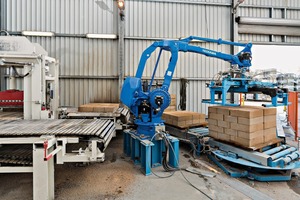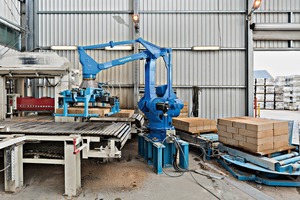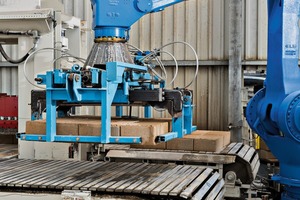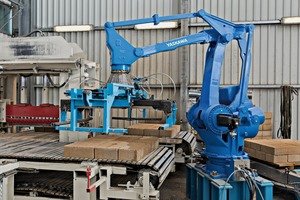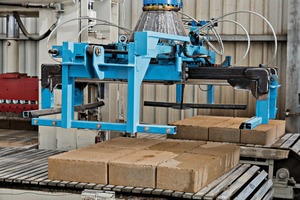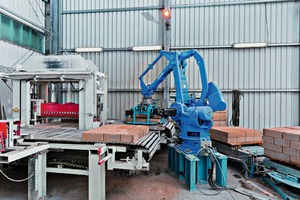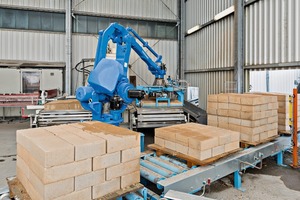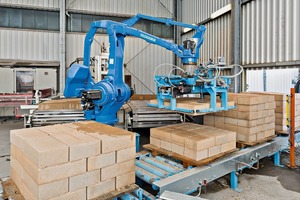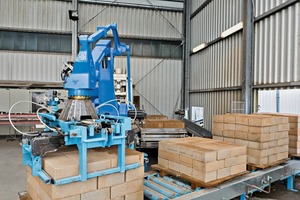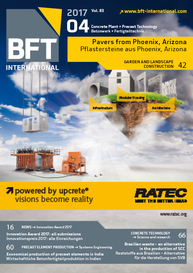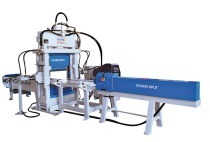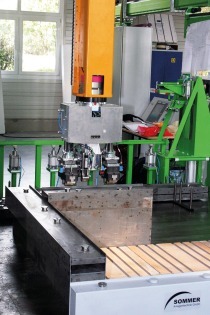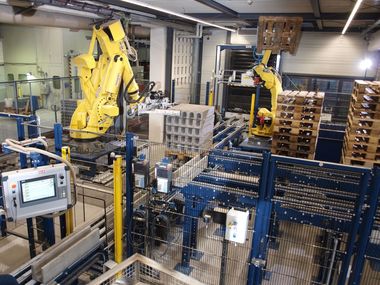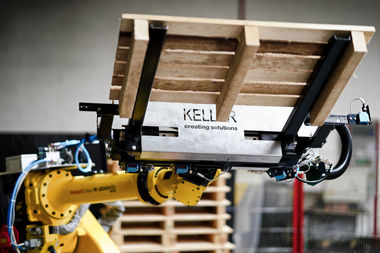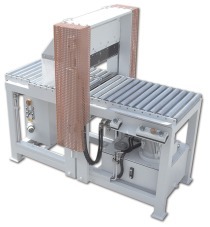Huber concrete plant uses Motoman MPL800 palletizing robot
The Huber concrete plant in Altomünster, Bavaria, produces about 600 tonnes of concrete goods daily in a variety of shapes and sizes. The main focus of the company’s production lies on stone dressing. Recently, a Yaskawa MPL800 palletizing robot went into action at the splitting machine used for the purpose. It feeds the stones to the machine layer by layer and removes them again. The robot and its controller are basically designed so that no further help is needed for operation. Manager Georg Huber was able to carry out the entire planning, installation and programming on his own – thus saving third-party costs.
The Huber family in Altomünster near Munich has been specializing in the manufacture of construction materials for over 100 years. Originally founded as a brickworks, the company’s production was converted to the manufacture of hollow blocks in the 1960 s and paving stones in the 1980 s. Since then its focus has been increasingly on a full range of garden and landscaping supplies. In the 1990 s a decision was made to concentrate on finished stones.
Robot reduces idle times
Common procedures are sandblasting, artificially ageing and splitting. In the latter process the stones are split, for example, to create the typical natural stone character. These products are then used, among other things, for retaining walls and garden landscaping. A Motoman MPL800 palletizing robot made by Yaskawa was recently introduced to feed stones into the splitting machine. Previously, two workers and a fork-lift truck were needed for the task. They can now be deployed to more important tasks elsewhere.
The splitting of stones is meanwhile a fully automatic process at the Huber concrete plant. For this purpose, stones that have already been palletized are conveyed on a feeder belt. Here the Motoman MPL800 awaits the unfinished product and takes hold of the top layer, lifting it onto a buffer zone in front of the splitting machine. From here the stones are carried on a conveyor belt to the splitting process. During this time the MPL800 takes a finished layer from the second buffer zone and stacks it on a pallet ready for shipment. The robot is always busy with loading and unloading – that reduces idle times and ensures maximum efficiency.
If the stones are to be split on several sides, the heavy duty MPL800 robot seizes the semi-finished layer on the output side of the splitting machine, rotates it and returns it to the splitter. Up to four sides of the stones can be dressed in this way. In this case waste material may result on the outside of the stones. So that this does not have to be removed manually, a slide is located next to the discharge buffer zone leading to a conveyor belt that carries splitter waste directly to a container. To transport the waste to the conveyor belt, the robot picks up the whole layer, i.e. including waste material, and places it so that the waste falls onto a conveyor belt when the gripper is briefly opened. It then deposits it, rotated by 180 degrees, in the buffer zone. The gripper opens briefly, allows splitter waste located on the other side of the layer to fall onto the conveyor belt, and takes it up again.
Broad range, high payload
The robot picks up between three and six stones per layer from the delivery pallet. After dressing there will be twelve to 21 stones, and it must handle loads ranging from 150 to 600 kg. Georg Huber has programmed the MPL800 for several motion sequences. For besides the individual layers of stones, some of which must be dressed on several sides, the machine also splits special formats such as curved stones. A further key requirement made on the robot: it must be able to perform its work within the limited space available. It was thus not necessary to construct a new production hall. Yaskawa’s Motoman MPL800 heavy duty robot is ideally suited to these varied palletizing tasks.
“Compact, flexible, powerful – these words can be used to describe Yaskawa’s Motoman MPL800,” Huber summarizes the characteristics of his new acquisition. Thanks to its broad vertical range of 3,024 mm and horizontal range of 3,159 mm with a payload of up to 800 kg, the four-axle Motoman MPL800 from the MPL series is ideal for use in the palletizing area. The fast acceleration rate and high speed of up to 1,200 palletizing cycles per hour play a key role here. The internal cable and conduit routing ensures a high degree of reliability as well as low interfering contours, and is particularly economical. From 80 kg to 100, 160, 300 and 500 kg up to a maximum weight of 800 kg, the model is available in different designs. Classical applications are heavy load handling, e.g. stones, entire pallets or other heavy parts in the process chain.
The MPL800 palletizing robot at the Huber concrete plant is controlled by a DX100 high-performance controller. This guarantees the highest level of movement precision and of consistency. The conveyor sections and splitting machine are controlled by a PLC. Both systems communicate via contact points and exchange information. Should a malfunction occur, the system switches off automatically, and all the necessary measures have been taken when it comes to safety. Huber has set up a hazard zone around the robot’s working area. Safety light barriers on the feed and discharge openings can differentiate between material and humans, and will switch it off if a person steps into the hazard zone during operation.
No outside help needed
“For me it’s important that I’m not dependent on a third party. That’s why I want to do as much as possible myself,” explains Huber. He remained true to this principle when he decided to entrust the palletizing tasks to a robot. First of all, he examined the different robot solutions. The close proximity of Yaskawa was one of the reasons he finally opted for a product made by the Japanese robot specialist. Huber not only planned and implemented the entire system himself. He also designed and built all the necessary parts, for example conveyor belts and buffer zones. One of the reasons he is so convinced of Yaskawa is that after a one-week training he was already in a position to undertake the robot teaching. Here again, no outside help was necessary. “I know that Yaskawa provides good service. But I prefer it when the product is so good that I have no need of service. That’s the case with my MPL800,” Huber laughs and winks at Jürgen Riedinger, Senior Sales Manager at the Yaskawa Robotics Division. And due to the positive experience Huber has already ordered a second Yaskawa robot to assume other future tasks in production.
With Yaskawa’s MPL800 palletizing robot and DX100 high-performance controller, despite space restrictions the Huber concrete plant was able to implement a fully automated splitting machine solution. The MPL800 assumes the task of transferring layers of stone with a weight of between 150 and 600 kg to a buffer zone in front of the splitting machine, then picking up and re-palletizing the ready split product. Thanks to the simple control of the robot a one-week course of training was sufficient to enable Manager Huber to set up the robot from the planning stage to teaching. In addition to the approx. 50 % increased productivity due to the robot, this has considerably reduced the costs for implementation.

